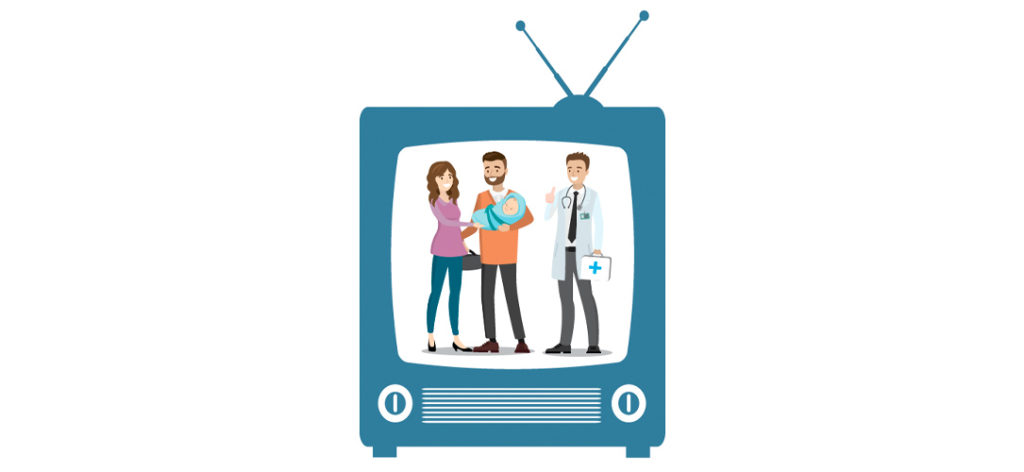I am not a doctor, but I have seen enough TV and movie births to make me an expert obstetrician. The babies I helped deliver on Friends alone should have been enough to earn my medical degree. Strangely, Hollywood has yet to send it.
Maybe that’s because most real-world babies are not born in a taxi or a Walmart. They do not pop out 3 months old, clean and speaking in voice-over narration. Mothers in labor rarely conjure up a demon-like voice. And I won’t even get into that scene in Twilight: Breaking Dawn.
But the movies do get one thing right: Something unexpected will happen. Though the idea of extracting one human from another sounds simple, it actually can be quite problematic. The complicated physiology of birth is nature’s way of introducing parents to just how unpredictable the subsequent 18 years will be. It’s as though every troublesome cervix or placenta serves as a precursor to the bike accidents and bad report cards that might follow.
After my daughter’s birth, I truly hoped this wasn’t the case. She arrived right on her due date, but little else went as planned. Although it happened over 17 years ago, the day has been seared into my brain the way that every traumatic yet heartwarming memory should be.
Jill, Sadie’s mother, did not experience the luxury of false labor. Instead, we coasted to the nine-month mark without any indication that Sadie ever planned to come out. Jill phoned me from what was supposed to be a routine doctor’s visit. Her blood pressure had surpassed certain parameters apparently established to frighten pregnant mothers. The logic behind voicing the word “emergency” to a full-term pregnant woman whose heart is already racing like a hummingbird’s still eludes me.
“We’re going to the hospital,” she said. “I need an emergency induction.”
I dropped everything and we raced to the hospital where Jill was wheeled into Labor and Delivery. Our “emergency” then came full circle, by which I mean she was connected to every available monitor and forced to fill out a ream of forms.
Four hours later, she was administered a slow drip of oxytocin. The intent was to stimulate contractions, but the result was just more time spent waiting for something—anything!—to happen. Starved for excitement, our conversation turned to how this new baby might affect our lives: midnight feedings, the cost of diapers, the emotional strain of skinned knees. Then, however, I mentioned all the cute clothes. Parenting anxiety can always be tempered by footie pajamas.
Twice, I made runs for food. The one valid excuse for abandoning a woman in the midst of her bearing your offspring is when she demands turkey salad. I felt guilty walking away, but the fact that we coursed through two mealtimes should bear witness to how slowly our “emergency” was progressing.
“Don’t give birth to anyone without me,” I said as I walked away, secretly hoping that I might return to find I was a sandwich short.
In the early evening, the midwife broke the amniotic sac with a crochet hook. That was when things got interesting. On the next contraction, Jill gritted her teeth as though she had seen someone wearing white pants in January. She managed only the words, “Drugs, now.” The epidural was administered with the same size of needle used to sedate Clydesdales. Minutes later, under the anesthesiologist’s magic spell, Jill professed that epidurals should be given in the second trimester.
Finally, around midnight, it was time to push. Jill slept between contractions, as did the nurse. When the monitor signaled a contraction, I woke everyone up and reminded them why we were there. After Sadie’s head appeared, in an event called “crowning,” anyone who passed by the room was invited in to touch it. This included two doctors, several nurses, and a man who had gotten lost while looking for the cafeteria.
The midwife had asked ahead of time if I wanted to cut the umbilical cord. They seemed short-staffed so I agreed, adding that they might want to find someone more qualified to assist with the other deliveries.
I knew the plan had been compromised the instant Sadie made her appearance. She looked like a wet cat, but that wasn’t the concerning part. The cord had snaked around Sadie’s neck, and the room came alive with panic.
“Call Peds for a floppy baby!” the midwife said.
The nurse hit a button on the wall, sounding an alarm and drawing in anyone who agreed that purple is a bad color for a newborn. Instantly, the room filled with white coats. The concern was Sadie’s Apgar score, a method of categorizing a baby’s initial condition based on: Appearance, Pulse, Grimace response (reflexes), Activity (muscle tone), and Respiration. Sadie had scored a 6 out of a possible 10, losing points certainly for her refusal to breathe or move. It would be her worst test score ever.
I stood there terrified, unable to process what was happening. Floppy? I had not signed on for floppy. They pulled our baby to the other side of the room and put her under one of those lamps for keeping pancakes warm at Denny’s.
Nurses surrounded Sadie as we waited in suspense. It was then that Sadie decided to breathe. Gasping and writhing, she released a loud whine and we knew she would be okay. No sound will ever be as sweet.
“But the movies do get one thing right: Something unexpected will happen. Though the idea of extracting one human from another sounds simple, it actually can be quite problematic.”
The scary part had lasted 20 seconds, but I’m certain it shaved two years off my life. I cried. Jill cried. Sadie cried. I hugged strangers and made them cry. That one moment of horror followed by unequaled joy would be relived in my head every day for months. Even now, when I tell the story, the details get embellished as the most perilous journey any baby has ever endured.
“Um, do you remember when Cadin was born?” my sister asked me recently, referring to her son who spent the first two weeks of his life in intensive care.
In addition to having a more harrowing birth story, my sister is also a midwife, giving her slightly more credentials than me. She insists that it is quite common for a newborn to need resuscitation. “It’s like the baby is holding its breath,” she says.
I’m sure she’s right. But when it’s your baby, there aren’t enough movie scenes in the world to prepare you for the wonder of that moment. If your bundle of joy turns you into a bundle of nerves, it just means you are ready to be a parent.





